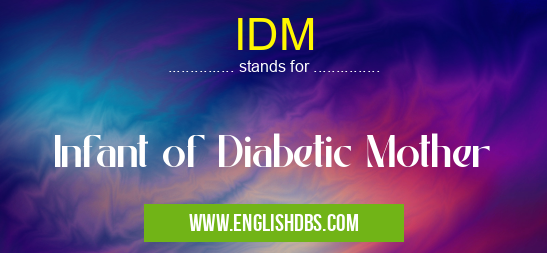What does IDM mean in UNCLASSIFIED
IDM stands for Infant of Diabetic Mother. It refers to a newborn baby whose mother has diabetes during pregnancy. Diabetes can affect the health of both the mother and the developing fetus, leading to potential complications for the infant.

IDM meaning in Unclassified in Miscellaneous
IDM mostly used in an acronym Unclassified in Category Miscellaneous that means Infant of Diabetic Mother
Shorthand: IDM,
Full Form: Infant of Diabetic Mother
For more information of "Infant of Diabetic Mother", see the section below.
Meaning of IDM
IDMs are at an increased risk for certain health conditions, including:
- Macrosomia: Excessive birth weight due to excess glucose exposure in the womb.
- Hypoglycemia: Low blood sugar levels after birth due to the mother's high blood sugar suppressing the baby's own glucose production.
- Respiratory distress syndrome: Difficulty breathing due to underdeveloped lungs.
- Jaundice: Yellowing of the skin and whites of the eyes due to a high level of bilirubin in the blood.
- Heart defects: Increased risk of certain heart abnormalities.
Monitoring and Care for IDMs
IDMs require close monitoring and specialized care to ensure their health and well-being. This includes:
- Regular blood sugar checks: To prevent hypoglycemia and monitor for hyperglycemia.
- Supplemental feedings: If necessary, to maintain adequate blood glucose levels.
- Monitoring for respiratory distress: Oxygen therapy may be needed if the baby develops breathing difficulties.
- Treatment for jaundice: Phototherapy or medication may be used to reduce bilirubin levels.
- Evaluation for heart defects: An echocardiogram may be performed to check for any abnormalities.
Essential Questions and Answers on Infant of Diabetic Mother in "MISCELLANEOUS»UNFILED"
What is an Infant of Diabetic Mother (IDM)?
An Infant of Diabetic Mother (IDM) refers to a child born to a mother with diabetes during pregnancy.
What are the risks associated with being an IDM?
IDMs may face an increased risk of:
- Premature birth
- Low birth weight
- Breathing difficulties
- Hypoglycemia (low blood sugar)
- Polycythemia (high red blood cell count)
- Cardiac abnormalities
- Metabolic complications
How can the risks of being an IDM be reduced?
Managing diabetes during pregnancy is crucial to reduce risks. This includes:
- Maintaining optimal blood sugar control before and during pregnancy
- Regular prenatal care
- Following a balanced diet
- Engaging in regular physical activity
What are the signs and symptoms of an IDM?
Signs and symptoms may include:
- Excess birth weight (>4 kg)
- Macrosomia (large body size)
- Hypoglycemia (low blood sugar)
- Respiratory distress
- Jaundice
- Congenital malformations
How is an IDM diagnosed?
Diagnosis is typically based on the mother's medical history and the infant's physical examination. Blood tests and imaging studies may also be performed.
What are the treatment options for an IDM?
Treatment will depend on the specific complications present. It may include:
- Monitoring blood sugar levels
- Administering glucose
- Providing respiratory support
- Managing electrolyte imbalances
- Treating any congenital malformations
Final Words: IDMs are newborns whose mothers have diabetes during pregnancy. They are at an increased risk for certain health conditions and require specialized care to ensure their health and development. Close monitoring and appropriate medical interventions are essential to prevent or manage any potential complications.
IDM also stands for: |
|
| All stands for IDM |
